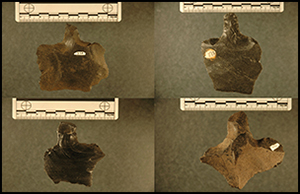Crossref Citations
This article has been cited by the following publications. This list is generated based on data provided by
Crossref.
Rull, Valentí
Cañellas-Boltà, Núria
Margalef, Olga
Pla-Rabes, Sergi
Sáez, Alberto
and
Giralt, Santiago
2016.
Three Millennia of Climatic, Ecological, and Cultural Change on Easter Island: An Integrative Overview.
Frontiers in Ecology and Evolution,
Vol. 4,
Issue. ,
Rull, Valentí
2016.
Natural and anthropogenic drivers of cultural change on Easter Island: Review and new insights.
Quaternary Science Reviews,
Vol. 150,
Issue. ,
p.
31.
DINAPOLI, ROBERT J.
and
MORRISON, ALEX E.
2017.
Human behavioural ecology and Pacific archaeology.
Archaeology in Oceania,
Vol. 52,
Issue. 1,
p.
1.
Simpson, Dale F.
and
Dussubieux, Laure
2018.
A collapsed narrative? Geochemistry and spatial distribution of basalt quarries and fine–grained artifacts reveal communal use of stone on Rapa Nui (Easter Island).
Journal of Archaeological Science: Reports,
Vol. 18,
Issue. ,
p.
370.
Rull, Valentí
2018.
Strong Fuzzy EHLFS: A General Conceptual Framework to Address Past Records of Environmental, Ecological and Cultural Change.
Quaternary,
Vol. 1,
Issue. 2,
p.
10.
DiNapoli, Robert J.
Morrison, Alex E.
Lipo, Carl P.
Hunt, Terry L.
and
Lane, Brian G.
2018.
East Polynesian Islands as Models of Cultural Divergence: The Case of Rapa Nui and Rapa Iti.
The Journal of Island and Coastal Archaeology,
Vol. 13,
Issue. 2,
p.
206.
Hixon, Sean W.
Lipo, Carl P.
McMorran, Ben
and
Hunt, Terry L.
2018.
The colossal hats (pukao) of monumental statues on Rapa Nui (Easter Island, Chile): Analyses of pukao variability, transport, and emplacement.
Journal of Archaeological Science,
Vol. 100,
Issue. ,
p.
148.
Lipo, Carl P.
DiNapoli, Robert J.
and
Hunt, Terry L.
2018.
Commentary: Rain, Sun, Soil, and Sweat: A Consideration of Population Limits on Rapa Nui (Easter Island) before European Contact.
Frontiers in Ecology and Evolution,
Vol. 6,
Issue. ,
Margalef, Olga
Álvarez‐Gómez, José A.
Pla‐Rabes, Sergi
Cañellas‐Boltà, Núria
Rull, Valentí
Sáez, Alberto
Geyer, Adelina
Peñuelas, Josep
Sardans, Jordi
and
Giralt, Santiago
2018.
Revisiting the role of high‐energy Pacific events in the environmental and cultural history of Easter Island (Rapa Nui).
The Geographical Journal,
Vol. 184,
Issue. 3,
p.
310.
STEVENSON, CHRISTOPHER M.
and
WILLIAMS, CAITLIN
2018.
The temporal occurrence and possible uses of obsidian mata'a on Rapa Nui (Easter Island, Chile).
Archaeology in Oceania,
Vol. 53,
Issue. 2,
p.
92.
DiNapoli, Robert J.
Lipo, Carl P.
Brosnan, Tanya
Hunt, Terry L.
Hixon, Sean
Morrison, Alex E.
Becker, Matthew
and
Hart, John P.
2019.
Rapa Nui (Easter Island) monument (ahu) locations explained by freshwater sources.
PLOS ONE,
Vol. 14,
Issue. 1,
p.
e0210409.
Rull, Valentí
2020.
Paleoecological Research on Easter Island.
p.
41.
DiNapoli, Robert J.
Rieth, Timothy M.
Lipo, Carl P.
and
Hunt, Terry L.
2020.
A model-based approach to the tempo of “collapse”: The case of Rapa Nui (Easter Island).
Journal of Archaeological Science,
Vol. 116,
Issue. ,
p.
105094.
2020.
Paleoecological Research on Easter Island.
p.
251.
Sanger, Matthew C.
Bourcy, Samuel
Ogden, Quinn Monique
and
Troutman, Michele
2020.
Post-marital Residence Patterns in the Late Archaic Coastal Southeast USA: Similarities in Stone Tools Revealed by Geometric Morphometrics.
Journal of Archaeological Method and Theory,
Vol. 27,
Issue. 2,
p.
327.
Wang, Li-Ying
and
Marwick, Ben
2020.
Standardization of ceramic shape: A case study of Iron Age pottery from northeastern Taiwan.
Journal of Archaeological Science: Reports,
Vol. 33,
Issue. ,
p.
102554.
Leplongeon, Alice
Ménard, Clément
Bonhomme, Vincent
and
Bortolini, Eugenio
2020.
Backed Pieces and Their Variability in the Later Stone Age of the Horn of Africa.
African Archaeological Review,
Vol. 37,
Issue. 3,
p.
437.
Lipo, Carl P.
Mischen, Pamela
and
Hunt, Terry L.
2020.
Knowledge for Governance.
Vol. 15,
Issue. ,
p.
25.
Rull, Valentí
2020.
The deforestation of Easter Island.
Biological Reviews,
Vol. 95,
Issue. 1,
p.
124.
DiNapoli, Robert J.
Lipo, Carl P.
and
Hunt, Terry L.
2021.
Triumph of the Commons: Sustainable Community Practices on Rapa Nui (Easter Island).
Sustainability,
Vol. 13,
Issue. 21,
p.
12118.



